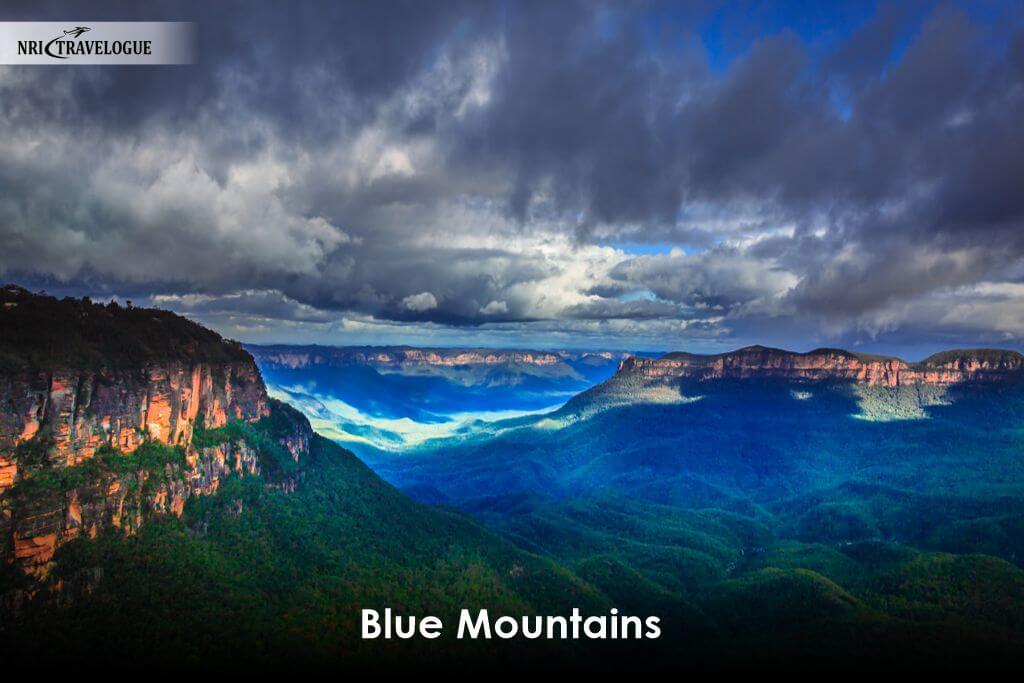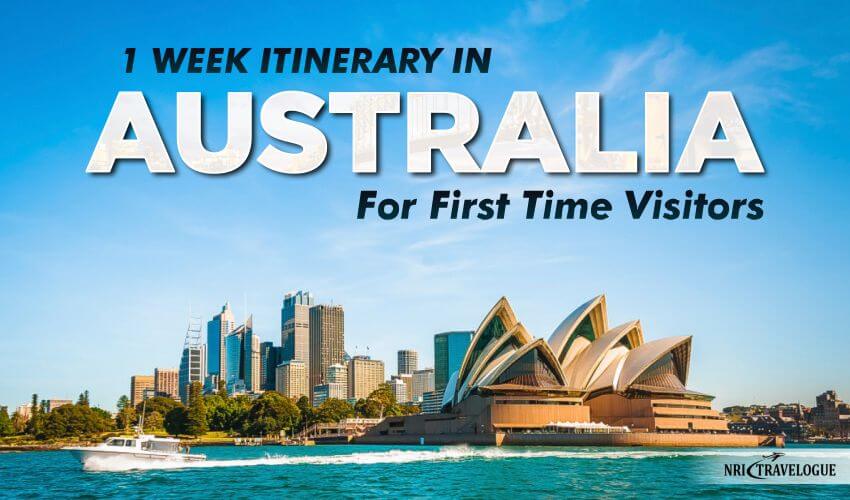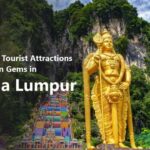Australia is a top travel destination with an unmatched combination of energetic cities, breathtaking natural scenery, and a rich cultural past. Australia, the home of well-known sites like the Great Barrier Reef and the Sydney Opera House, enthralls tourists with its wide range of experiences.
The untamed beauty of the Outback and the tranquil beaches of the Gold Coast contrast exquisitely with the sophisticated elegance of cities like Sydney and Melbourne, which are renowned for their arts, cuisine, and culture.
Nature lovers may discover Uluru’s spectacular red expanse, the ancient rainforests of Daintree, and the Great Ocean Road’s breathtaking coastline views. Encounters with distinctive species in their natural settings, such as kangaroos, koalas, and marine life, will excite wildlife enthusiasts.
The 1-week trip to Australia is enhanced by its rich Indigenous culture, which provides profound insights into the history and connection to the land of the country.
Australia has a reputation for safety, inviting visitors from all over the world, pleasant residents, and first-rate infrastructure.
Regardless of your travel goals—adventure, leisure, or cultural immersion—Australia assures a life-changing trip full of fascinating encounters. Here’s your one-week itinerary that we have exclusively planned for you.
Day 1: Sydney
Start your 1-week Australia itinerary journey by seeing the Sydney Opera House first thing in the morning. Learn about the building’s history, layout, and events by going on a guided tour.

Sydney’s principal ferry terminal, Circular Quay, is a busy hub. There are cafes and eateries all around it. Savor a coffee while taking in views of the Opera House and Sydney Harbour Bridge.
Take a stroll over this famous bridge or, for a more daring adventure, sign up for the BridgeClimb to get sweeping views of Sydney and its harbor. It takes roughly three hours to climb, and the view of the city is appealing. After that, schedule a trip to The Rocks, a historic neighborhood with markets, boutique stores, cobblestone streets, and old-fashioned pubs.
If you’re there on a weekend, have a look at the Rocks Discovery Museum to learn more about the history of the area, or just spend time exploring the markets.
A trip to Darling Harbour in the evenings is a must. This lively waterfront neighborhood is ideal for nighttime activities. Visit places like the Sydney Zoo and Aquarium (SEA LIFE Sydney). Enjoy supper at one of the many waterfront restaurants and enjoy the views.
Day 2: Bondi Beach
The next attraction on your Australia itinerary for today is Bondi Beach. Enjoy a morning at the renowned Bondi Beach. Take a dip in the crystal-clear seas, surf, or just unwind on the golden dunes. The Bondi to Coogee coastal trail is a picturesque stroll that goes by several more lovely beaches and provides stunning views of the ocean.

From Circular Quay, get a ferry to Taronga Zoo, which is situated on Sydney Harbour’s northern coasts. More than 4,000 animals from all over the world, including numerous native Australian species, are kept in the zoo. Savor the interactive experiences, keeper talks, and shows.
Take a dinner cruise in Sydney Harbor to cap off your day. There are numerous choices, from laid-back buffet cruises to elegant dining establishments. Admire the Harbour Bridge, the Opera House lit up at night, and the cityscape.
Day 3: Blue Mountains
Your 3rd day of 1 week Australia itinerary starts from the Blue Mountains. Make plans to visit the Blue Mountains National Park on Day 3.

Visit this breathtaking national park for the day; it’s around a two-hour drive from Sydney. Highlights consist of:
- Three Sisters: Well-known rock feature with importance for the Aboriginal people. For breathtaking views, head to the Echo Point observation.
- Scenic Walkway: Take a ride on the world’s steepest passenger railway, the glass-bottomed cable car, the Scenic Walkway, and a boardwalk through a rainforest.
- Hiking paths: There are lots of paths that give breathtaking views of valleys, waterfalls, and eucalyptus woods. They range in difficulty from short strolls to strenuous hikes.
Explore for a day, then head back to Sydney to unwind.
Day 4: Cairns and Great Barrier Reef
In your 1-week Australia Itinerary including Cairns and Great Barrier Reef, explore the small islands and reefs of the northern Great Barrier Reef on day 4th.

Take an early flight in the morning to Cairns, which is the entry point to the Great Barrier Reef. It will be afternoon when you get there. Take a diving or snorkeling excursion to the Great Barrier Reef. Numerous companies provide day tours that come with food, equipment, and expert snorkeling and diving instruction. The beautiful coral reefs and aquatic creatures, such as rays, fish, and sea turtles will enchant you!
Enjoy the evening at the bustling Cairns Esplanade, which features a swimming lagoon, boardwalk, and recreational amenities. Savor dinner at one of the many eateries serving you regional cuisines and fresh fish.
Day 5: Cairns and Daintree Rainforest
In your 1 week Australia Itinerary you must visit Cairns and Daintree Rainforest, the Daintree National Park is popular for being one of the most biodiverse rainforest areas in the world.

Experience the world’s oldest rainforest, the Daintree Rainforest, on a guided trip.
Highlights consist of:
- Mossman Gorge: Take a stroll through the rainforest and cool yourself in the Mossman River’s crystal-clear waters.
- Daintree Riverboat: Take a riverboat to see wildlife, including crocodiles.
- Go to Cape Tribulation, where the reef and rainforest converge. Take a stroll along the immaculate beaches, investigate the mangroves along the shore, and take in the calm surroundings.
- For dinner, you may visit the small hamlet of Port Douglas. This town is well-known for its tasty food options and relaxed atmosphere. While strolling down Macrossan Street, you come across many restaurants.
Day 6: Melbourne
Travel via morning flight to Melbourne. Discover the cultural center of Melbourne:

- Laneways and Arcades: Explore the city’s laneways and arcades, which are well-known for their boutique stores, cafes, and street art.
- Federation Square: A hub for social interaction and a cultural district with eateries, museums, and galleries.
- Flinders Street Station: This historic train station is a popular photo location and one of Melbourne’s most identifiable features.
- Royal Botanic Gardens: A peaceful haven in the middle of the city with lakes, strolling trails, and exquisitely designed gardens.
- Visit St. Kilda, a district by the seaside renowned for its bohemian atmosphere. Stroll along the waterfront, pay a visit to the famous amusement park Luna Park, and take in the sunset. Sample the renowned sweets from the bakeries on Acland Street.
Day 7: Great Ocean Road
Take a day journey along one of the most picturesque coastal drives in the world, the Great Ocean Road. Among the highlights are:

- Bells Beach, a well-known surf beach close to Torquay.
- Great Otway National Park: This park has lovely trekking trails, waterfalls, and rainforests.
- The Twelve Apostles: Magnificent limestone pillars towering out of the sea. For another viewpoint, go to the Gibson Steps, which are close by.
- Proceed on your drive along the Great Ocean Road, making stops at picturesque lookouts and quaint seaside communities like Apollo Bay and Lorne.
- Return to Melbourne for your farewell dinner. Savor a last meal at one of the city’s well-known eateries, like those in the Southbank neighborhood.
Wrapping Up
Australia trip itinerary provides an unmatched combination of dynamic cities, breathtaking natural scenery, and a rich cultural legacy. It serves a wide range of interests, from the famous Sydney Opera House and Great Barrier Reef to the untamed Outback and immaculate beaches.
Read also: Places to Visit in Australia
Australia’s distinct fauna, which includes koalas and kangaroos, contributes to its appeal. Australia delivers amazing experiences with its friendly people, top-notch food, and adventure activities. tourists will find Australia’s unique landscapes and attractions enthralling, making it a must-visit destination for tourists worldwide, whether they choose to explore sophisticated cities, engage in outdoor activities, or immerse themselves in Aboriginal culture.
The best time to visit Australia and plan your itinerary is September to November and March to May. For Sydney and Melbourne, spring and fall offer the finest weather and the fewest crowds.
You can visit Cairns and the Great Barrier Reef around June through October is the best time to visit for great weather and visibility for diving and snorkeling during the dry season. The best time to discover Tasmania’s natural beauty is during the summer, from December to February.
To enter Australia, the majority of foreign travelers require a visa. Depending on your country and the reason for your visit, a different kind of visa may be needed. For information on specific visa requirements and application processes, be sure to visit the Department of Home Affairs website of the Australian government.
Australia’s transportation system is well-developed, and there are several ways to get around:
- Domestic flights: These are the most economical way to travel vast distances between cities like Sydney, Melbourne, and Cairns.
- Trains and Buses: Public transportation in major cities is well-developed and includes bus, tram, and train services. Although small, the interstate train network is accessible.
- Car Rentals: If you want to go at your own speed through areas like the terrific Ocean Road and the Blue Mountains, renting a car is a terrific alternative.
- Ride-sharing and Taxis: In cities, it’s common to find both regular taxis and services like Uber.
Australian cuisine is diverse and influenced by its multicultural population. Some must-try foods include meat pies, Lamingtons, Barramundi, Vegemite, Tim Tams and Pavlova.
Australia is generally a safe destination for tourists, with a low crime rate and excellent healthcare facilities. However, it’s important to take standard safety precautions like wearing sunscreen, hats, and sunglasses, and staying hydrated.
Only swim at patrolled beaches between the flags, as riptides can be dangerous. Pay attention to warning signs about marine stingers or sharks. Be aware of wildlife, especially when hiking or driving in rural areas.
Pack lightweight, breathable clothing for summer, and layers for cooler months. Include swimwear, a hat, and a light rain jacket. Do not forget, comfortable walking shoes for city exploration and sturdy shoes for hiking.
Carry your medications, basic first aid supplies, and insect repellent. Finally, reusable water bottles, travel documents (passport, visa, travel insurance), and a guidebook or map are necessary.









